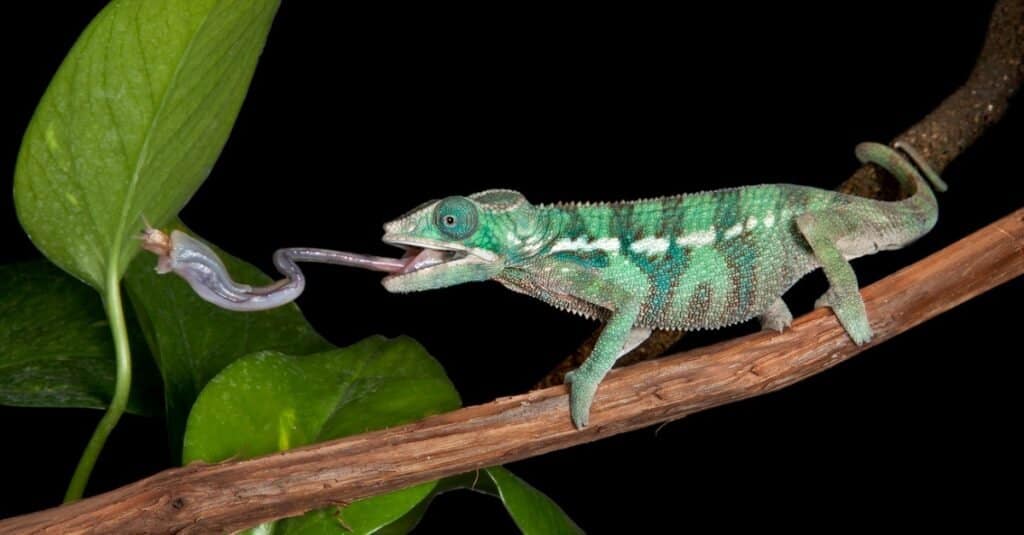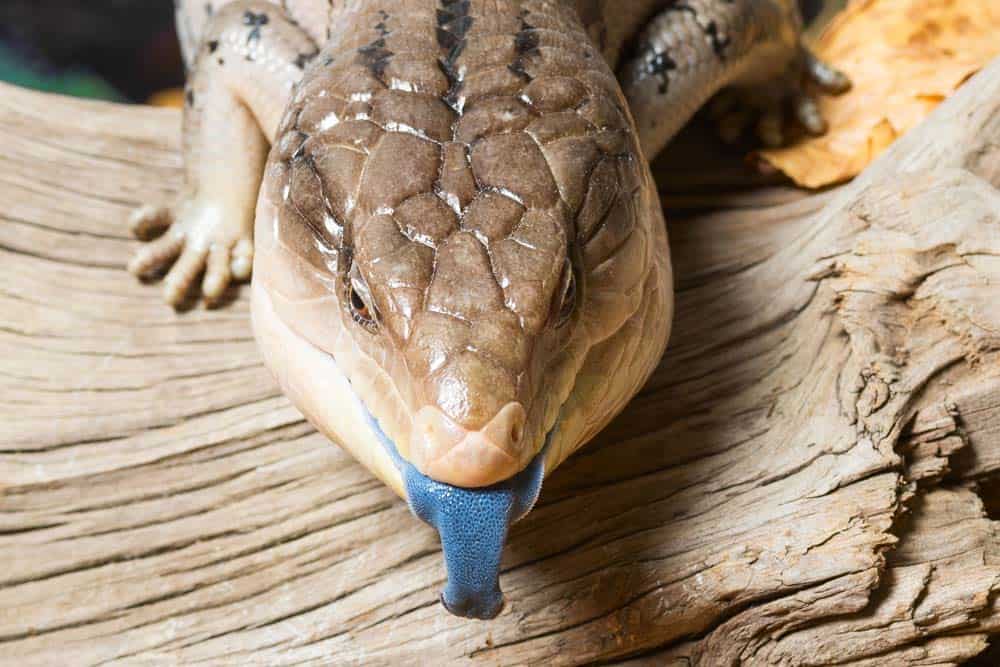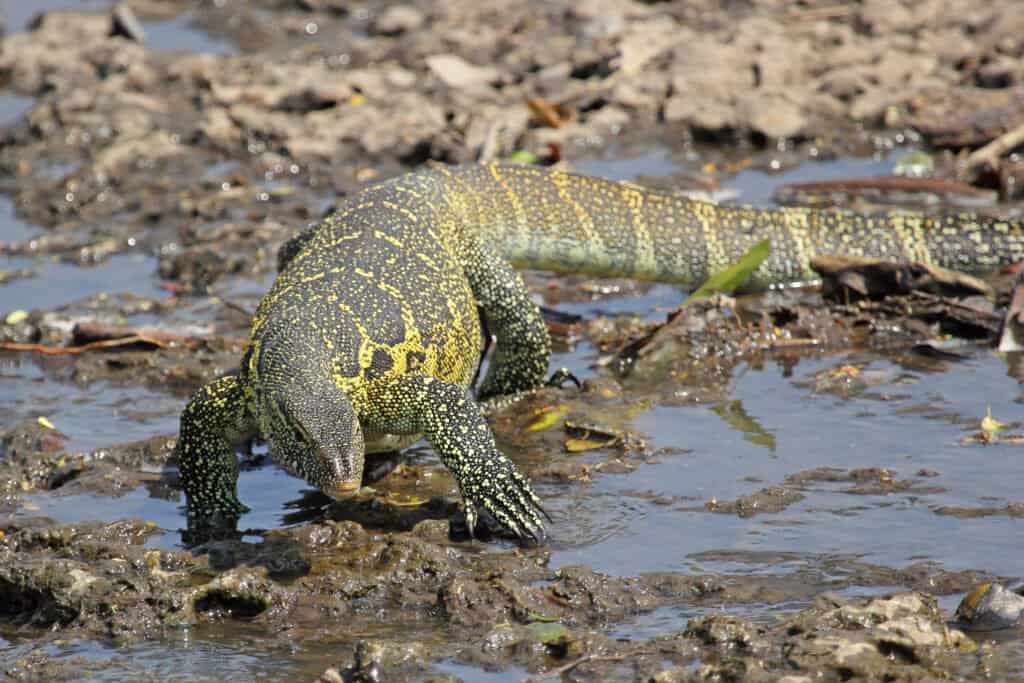
A panther chameleon baby is catching a cricket by extending his tongue. Chameleons are one of the best lizards because of their ability to change colors.
©iStock.com/CathyKeifer
A lizard’s tongue is unique, and one of its most important body parts. Oftentimes its tongue is seen flicking in and out of its mouth, but this is much more than just a weird quirk. If you have a pet lizard, or regularly view them in the wild you might wonder what function their tongue plays and why it moves in such a way. Lizards use their tongue to smell and are important in helping them navigate the world.
Not every lizard tongue is built the same, but most species use their tongue for similar reasons. Lizard tongues smell the air, helping them find prey, and know when a predator is nearby. Humans use their tongues to eat, and this can also help assist in the sense of smell. Our noses do most of the smelling, but a lizard’s tongue is the main factor in how they smell.
In this article, you will learn all about the lizard’s tongue, and how this unique part of their body plays a role in their everyday life. Some lizards species have other uses for their tongue and rely on different senes that we may not have. Here is everything you should know about a lizard’s tongue.
Why Lizard Sticks Its Tongue Out

Many lizards – such as the bluetongue skins – have tongues that have unique coloration.
©LesPalenik/Shutterstock.com
If you ever examined a lizard you might have noticed how often they flick their tongue in and out of their mouth. Doing this helps them sense the world, and gather information around them. When flicking their tongue they are gathering scent particles that give them a more detailed smell.
Around the nasal cavity of lizards and snakes is Jacobson’s organ, also named the vomeronasal organ. This organ is used for chemoreception and is also present in some mammals and amphibians.
Lizards stick their tongue out to smell and pull the scent particles in to be sensed. Snakes also use this method to sense the world, and why they are seen doing the same tongue motion as lizards. Doing this flicking motion helps lizards smell better, and collect more scent particles.
Lizards’ sense of smell is an important way in how they sense the world. They use smell to survive and do things like find prey.
How Lizards Use Their Sense Of Smell

Some snakes have very poor eyesight, but certain lizard species are able to see better than humans.
©Pics Man24/Shutterstock.com
When a lizard flicks its tongue around it is using it to smell, and they do this motion so often since smell is an important factor in how they take in information about the world around them.
Smell is one of the lizard’s strongest senses, but they still rely on other senses. Its strong smell builds its awareness and gives it the knowledge of the world around it.
Here are some ways a lizard uses its sense of smell:
- Track nearby food
- Locate nearby predators
- Communicate with pheromones
- Find a mate
The strong smell of a lizard is used in different aspects of their daily life and is why their tongue is so important. A lizard’s tongue is beneficial for smelling, but some species also use their tongue for other unique reasons.
Unique Ways Different Lizards Use Their Tongue

Monitor lizards and Gila monsters are species with a forked tongue, similar to snakes.
©MattiaATH/Shutterstock.com
With such a large diversity of lizards species in the world, some may have other uses for their tongue. A great example of a lizard with a unique tongue is the blue-tongued skink. Blue-tongued skinks have blue tongues like their name suggests, and stick them out to smell like other lizards. They will also stick out their blue tongues when a predator is near, using the odd color to frighten any predator.
Lizards such as the various monitor lizard species have forked tongues similar to that of a snake. Lizards and snakes with forked tongues swing them side to side to help increase their smelling sense. When a tongue is forked it has a large surface area and a better sense of smell. Only some lizard species have this tongue, and it is more prevalent in snakes.
Chameleons are known for their amazing tongue, which can stretch 2.5 times its body length to catch small insects. They use their tongue to smell as well, but it is best known for how long it is. Chameleons have the longest tongue of any lizard. These lizards also have the fastest tongues of any species, and smaller chameleons will have faster tongues. Their tongues are able to travel from 0 to 60mph in a hundredth of a second.
How Lizards Sense The World

Gecko species have amazing night vision, which can supplement their sense of smell.
©Artush/Shutterstock.com
A lizard smelling ability is important in its survival, but they also have other ways in which they sense the world. Lizards use sight, smell, hearing, and touch like other animals. Some species are better at one sense than the other, but smell is commonly used amongst all species of lizards.
Eyesight is an important way a lizard views the world, and studies have shown that lizards are able to view a large range of colors that humans can’t perceive. At night nocturnal lizards can see very clearly, like how humans would see during the day. Lizards like the tokay gecko and other gecko species have amazing night vision, which is helpful in spotting predators.
Chameleons are another species with great eyesight. Like their tongue, their eyes are unique to the chameleon. Chameleon eyes protrude from their head and are shaped like a cone. Their eyes are able to move in two different directions and give the lizard 360 degrees of vision. Chameleons and some other lizards are also able to see UV light.
The photo featured at the top of this post is © LouieLea/Shutterstock.com
Thank you for reading! Have some feedback for us? Contact the AZ Animals editorial team.







